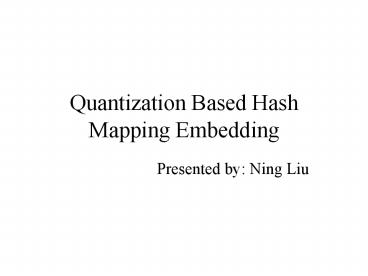Quantization Based Hash Mapping Embedding - PowerPoint PPT Presentation
1 / 9
Title:
Quantization Based Hash Mapping Embedding
Description:
Quantization Based Hash Mapping Embedding. Presented by: Ning Liu. U ... minimizing the distortion in the host image ... {d=Quant(x)-X0 s.t. T(Quant(x)/q) ... – PowerPoint PPT presentation
Number of Views:50
Avg rating:3.0/5.0
Title: Quantization Based Hash Mapping Embedding
1
Quantization Based Hash Mapping Embedding
- Presented by Ning Liu
2
General Data Hiding Scheme
U
Y
X
Attack (N)
Recovered Data (W)
Embedded Data (W)
Tradeoff in 3 aspects
- minimizing the distortion in the host image due
to embedding, - maximizing the robustness of information hiding,
- maximizing the capacity of the scheme
3
Costas Idea
P the transmitter power constraint, Z the
channel noise
W the hiding-data
S side information (host image)
4
Costas Scheme
The channel is AWGN and the signal (side
information, S) is i.i.d. Gaussian distributed.
The capacity is given as
where P and N represent the transmitter power
constraint and the variance of the channel noise
respectively . The space of codewords must be of
the form
The ideal Costa scheme (ICS) is not practical
due to the large size of the random codebook
5
Secure Quantization based Data-Embedding
- We study the combined security, robustness and
host distortion enhancement of quantization index
modulation (QIM) based data hiding for multimedia
security. - We compare our algorithm with the one proposed by
Wu 1, who shows that through a lookup table
(LUT) of nontrivial run that maps quantized
multimedia features randomly to binary data, the
probability of detection error can be
considerably smaller than the traditional
quantization embedding. - We note that in her algorithm we would have to
overlook the distortion constraint to achieve
robustness. - On the contrary, in the proposed algorithm, we
propose to elegantly trade off security,
robustness, without increasing distortion to the
host. - we show that the proposed hash mapping embedding
provides joint enhancement of security and
robustness over the LUT embedding while
maintaining the distortion constraint.
6
LUT Embedding-1
- The encoder generates a LUT before hand, denoted
by T(.). - In a random manner, the LUT maps every quantizer
representation value to a binary 0 or a binary
1, while setting the probability of either
mapping at 0.5. - To embed a 0 (or a 1), the feature is
quantized to the closest representation value
that is mapped to a 0 (or a 1) as seen in
equation below. - Here, d min dQuant(x)-X0 s.t.
T(Quant(x)/q)b - Conversely, the extraction is done by looking up
the LUT as seen in equation below. - The number of 1 and 0 mappings have to be
constrained in the LUT to avoid excessive
modification to the host.
q
d
7
Security Strength of LUT Scheme
- The security strength of LUT depends on the
maximum run, r. - a) A Markov chain model for LUT table generation,
where the transition probability is ½ for solid
arrow lines and 1 for dash arrow lines. - b) The entropy rate of LUT table as a function of
the maximum allowable run r.
8
Distortion Analysis of LUT Scheme
..
X
X
X
O
X
X
O
X
O
O
- If the maximum allowable run of 1 and 0 is
denoted by r, and if it is set to 1, we note that
this leads to a maximum of two possible tables as
seen below. - It is noted that the MSE distortion for odd-even
quantization based scheme is q2/3 as compared to
the MSEA distortion by Wus algorithm (maximum
allowable run r2) is q2/2. For larger r, MSEA
will be even larger than q2/2 - We note that the security enhancement of LUT
embedding is at the cost of distortion caused by
embedding
9
Proposed scheme
- Wu in 1, states that the security strength is
achieved by LUT embedding at the cost of the
robustness in terms of probability of detection
error, especially in a high WNR range. In this
paper, we propose a new scheme, which can achieve
security strength without sacrificing the
robustness, while maintaining the distortion
constraint.































